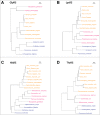The aminoacyl-tRNA synthetases of Drosophila melanogaster
- PMID: 26761199
- PMCID: PMC4826098
- DOI: 10.1080/19336934.2015.1101196
The aminoacyl-tRNA synthetases of Drosophila melanogaster
Abstract
Aminoacyl-tRNA synthetases (aaRSs) ligate amino acids to their cognate tRNAs, allowing them to decode the triplet code during translation. Through different mechanisms aaRSs also perform several non-canonical functions in transcription, translation, apoptosis, angiogenesis and inflammation. Drosophila has become a preferred system to model human diseases caused by mutations in aaRS genes, to dissect effects of reduced translation or non-canonical activities, and to study aminoacylation and translational fidelity. However, the lack of a systematic annotation of this gene family has hampered such studies. Here, we report the identification of the entire set of aaRS genes in the fly genome and we predict their roles based on experimental evidence and/or orthology. Further, we propose a new, systematic and logical nomenclature for aaRSs. We also review the research conducted on Drosophila aaRSs to date. Together, our work provides the foundation for further research in the fly aaRS field.
Keywords: Charcot-Marie-Tooth neuropathy; Drosophila gene family; aminoacyl-tRNA synthetase; multifunctional protein, translation.
Figures



References
-
- Schimmel PR, Soll D. Aminoacyl-tRNA synthetases: general features and recognition of transfer RNAs. Annu Rev Biochem 1979; 48:601-48; PMID:382994; http://dx.doi.org/10.1146/annurev.bi.48.070179.003125 - DOI - PubMed
-
- Schimmel P. Development of tRNA synthetases and connection to genetic code and disease. Protein Sci 2008; 17:1643-52; PMID:18765819; http://dx.doi.org/10.1110/ps.037242.108 - DOI - PMC - PubMed
-
- Ibba M, Soll D. Aminoacyl-tRNA synthesis. Annu Rev Biochem 2000; 69:617-50; PMID:10966471; http://dx.doi.org/10.1146/annurev.biochem.69.1.617 - DOI - PubMed
-
- de Duve C. Transfer RNAs: the second genetic code. Nature 1988; 333:117-8; PMID:3367984; http://dx.doi.org/10.1038/333117a0 - DOI - PubMed
-
- Arnez JG, Moras D. Structural and functional considerations of the aminoacylation reaction. Trends Biochem Sci 1997; 22:211-6; PMID:9204708; http://dx.doi.org/10.1016/S0968-0004(97)01052-9 - DOI - PubMed
Publication types
MeSH terms
Substances
Grants and funding
LinkOut - more resources
Full Text Sources
Other Literature Sources
Molecular Biology Databases
Miscellaneous
